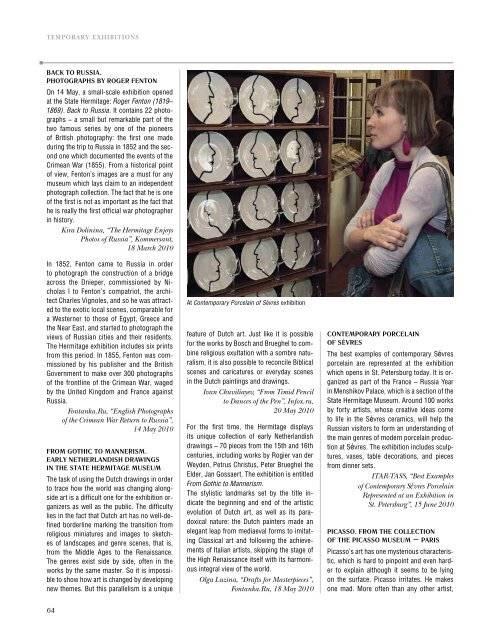The STaTe hermiTage muSeum annual reporT
The STaTe hermiTage muSeum annual reporT
The STaTe hermiTage muSeum annual reporT
Create successful ePaper yourself
Turn your PDF publications into a flip-book with our unique Google optimized e-Paper software.
temporary exhIbItIons<br />
BacK To ruSSia.<br />
phoTographS By roger fenTon<br />
On 14 May, a small-scale exhibition opened<br />
at the State Hermitage: Roger Fenton (1819–<br />
1869). Back to Russia. It contains 22 photographs<br />
– a small but remarkable part of the<br />
two famous series by one of the pioneers<br />
of British photography: the first one made<br />
during the trip to Russia in 1852 and the second<br />
one which documented the events of the<br />
Crimean War (1855). From a historical point<br />
of view, Fenton’s images are a must for any<br />
museum which lays claim to an independent<br />
photograph collection. <strong>The</strong> fact that he is one<br />
of the first is not as important as the fact that<br />
he is really the first official war photographer<br />
in history.<br />
Kira Dolinina, “<strong>The</strong> Hermitage Enjoys<br />
Photos of Russia”, Kommersant,<br />
18 March 2010<br />
In 1852, Fenton came to Russia in order<br />
to photograph the construction of a bridge<br />
across the Dnieper, commissioned by Nicholas<br />
I to Fenton’s compatriot, the architect<br />
Charles Vignoles, and so he was attracted<br />
to the exotic local scenes, comparable for<br />
a Westerner to those of Egypt, Greece and<br />
the Near East, and started to photograph the<br />
views of Russian cities and their residents.<br />
<strong>The</strong> Hermitage exhibition includes six prints<br />
from this period. In 1855, Fenton was commissioned<br />
by his publisher and the British<br />
Government to make over 300 photographs<br />
of the frontline of the Crimean War, waged<br />
by the United Kingdom and France against<br />
Russia.<br />
Fontanka.Ru, “English Photographs<br />
of the Crimean War Return to Russia”,<br />
14 May 2010<br />
from goThic To manneriSm.<br />
early ne<strong>The</strong>rlandiSh drawingS<br />
in <strong>The</strong> <strong>STaTe</strong> <strong>hermiTage</strong> <strong>muSeum</strong><br />
<strong>The</strong> task of using the Dutch drawings in order<br />
to trace how the world was changing alongside<br />
art is a difficult one for the exhibition organizers<br />
as well as the public. <strong>The</strong> difficulty<br />
lies in the fact that Dutch art has no well-defined<br />
borderline marking the transition from<br />
religious miniatures and images to sketches<br />
of landscapes and genre scenes, that is,<br />
from the Middle Ages to the Renaissance.<br />
<strong>The</strong> genres exist side by side, often in the<br />
works by the same master. So it is impossible<br />
to show how art is changed by developing<br />
new themes. But this parallelism is a unique<br />
At Contemporary Porcelain of Sèvres exhibition<br />
feature of Dutch art. Just like it is possible<br />
for the works by Bosch and Brueghel to combine<br />
religious exultation with a sombre naturalism,<br />
it is also possible to reconcile Biblical<br />
scenes and caricatures or everyday scenes<br />
in the Dutch paintings and drawings.<br />
Ivan Chuviliayev, “From Timid Pencil<br />
to Dances of the Pen”, Infox.ru,<br />
20 May 2010<br />
For the first time, the Hermitage displays<br />
its unique collection of early Netherlandish<br />
drawings – 70 pieces from the 15th and 16th<br />
centuries, including works by Rogier van der<br />
Weyden, Petrus Christus, Peter Brueghel the<br />
Elder, Jan Gossaert. <strong>The</strong> exhibition is entitled<br />
From Gothic to Mannerism.<br />
<strong>The</strong> stylistic landmarks set by the title indicate<br />
the beginning and end of the artistic<br />
evolution of Dutch art, as well as its paradoxical<br />
nature: the Dutch painters made an<br />
elegant leap from mediaeval forms to imitating<br />
Classical art and following the achievements<br />
of Italian artists, skipping the stage of<br />
the High Renaissance itself with its harmonious<br />
integral view of the world.<br />
Olga Luzina, “Drafts for Masterpieces”,<br />
Fontanka.Ru, 18 May 2010<br />
conTemporary porcelain<br />
of SèvreS<br />
<strong>The</strong> best examples of contemporary Sévres<br />
porcelain are represented at the exhibition<br />
which opens in St. Petersburg today. It is organized<br />
as part of the France – Russia Year<br />
in Menshikov Palace, which is a section of the<br />
State Hermitage Museum. Around 100 works<br />
by forty artists, whose creative ideas come<br />
to life in the Sévres ceramics, will help the<br />
Russian visitors to form an understanding of<br />
the main genres of modern porcelain production<br />
at Sévres. <strong>The</strong> exhibition includes sculptures,<br />
vases, table decorations, and pieces<br />
from dinner sets.<br />
ITAR-TASS, “Best Examples<br />
of Contemporary Sévres Porcelain<br />
Represented at an Exhibition in<br />
St. Petersburg”, 15 June 2010<br />
picaSSo. from <strong>The</strong> collecTion<br />
of <strong>The</strong> picaSSo <strong>muSeum</strong> – pariS<br />
Picasso’s art has one mysterious characteristic,<br />
which is hard to pinpoint and even harder<br />
to explain although it seems to be lying<br />
on the surface. Picasso irritates. He makes<br />
one mad. More often than any other artist,<br />
contemporary or not, he provokes the reaction<br />
of “I don’t understand him”.<br />
Nevertheless, any Picasso exhibition is always<br />
crowded. And the crowd can be neatly<br />
divided into two halves. Some visitors derive<br />
an interest and pleasure incomprehensible<br />
to others from viewing the master’s paintings,<br />
drawings, and sculptures; while the<br />
other half either sneers in derision, swears,<br />
or stops by his entirely realistic, even Salon-like,<br />
portrait of his third woman and first<br />
wife, the Russian ballerina Olga Khokhlova,<br />
only to exclaim in indignant bewilderment:<br />
“He can do it normally when he wants to, so<br />
what’s the hell?”<br />
Nikita Yeliseyev, “<strong>The</strong> Borders<br />
of Picasso”, Expert Severo-Zapada,<br />
30 August 2010<br />
It is incredible how Picasso has managed to<br />
take the Winter Palace by storm without firing<br />
a single shot (no revolutionary sailors but<br />
several designers were involved). Or, strictly<br />
speaking, it is the main state rooms of the<br />
Winter Palace (the Field Marshall, Armorial,<br />
and Piquet Rooms), as well as the Eastern<br />
Gallery and the Rooms of the Courtyard Gallery<br />
in the second floor.<br />
Before the opening of the exhibition, the Director<br />
of the Picasso Museum Anne Baldassari<br />
took a whirlwind tour of the rooms in<br />
order to make sure that the collection was<br />
ready to be shown to the public. And this is<br />
when she was asked whether she thought<br />
that Picasso the rebel and non-conformist<br />
had managed to conquer the Winter Palace,<br />
that Everest of Imperial spirit? And her answer<br />
was clear: Of course he has, how could<br />
it be otherwise?<br />
Artur Mezentsev, “Parad-Alle<br />
of Pablo Picasso”, Peterburgsky Chas Pik,<br />
23 June 2010<br />
This exhibition is doomed to success, and<br />
not only because it is promoted as the main<br />
event of the France – Russia Year and has<br />
the special patronage of the Presidents<br />
of both countries. This is the first display of<br />
Picasso’s works on such a scale in Russia.<br />
<strong>The</strong> famous 1956 exhibition at the Hermitage,<br />
which paved the way for new art in this<br />
country, had four times fewer exhibits.<br />
One of the important things about the exhibition<br />
is that it is located in the state rooms of<br />
the Winter Palace. Not every artist can survive<br />
such surroundings. A huge space full of architectural<br />
detail, bas-reliefs, and colours,<br />
At Picasso. From the Collection of the Picasso Museum – Paris exhibition<br />
tends to be oppressive. But Picasso holds his<br />
ground, putting up a good fight. It turns out<br />
the space is worthy of him.<br />
Ludmila Leusskaya, “Pablo and His<br />
Models”, Sankt-Peterburgskie Vedomosti,<br />
21 June 2010<br />
“Since ToBacco you love<br />
So much...”<br />
At the opening of the Hermitage exhibition<br />
“Since Tobacco You Love So Much...”, dedicated<br />
to the tobacco accessories in art, the<br />
Director of the museum Mikhail Piotrovsky<br />
admitted that in his youth, he used to smoke<br />
Belomor during the field trips. But he had<br />
given it up in time. This was the end of the<br />
unhealthy topic, and everyone proceeded<br />
to view the snuffboxes, tobacco pouches,<br />
pipes, cigar cases and match boxes made<br />
of porcelain, amber and precious metals.<br />
V.Sh., “<strong>The</strong> Nineteenth-Century Hydrogen<br />
Bomb”, Gorod, 27 September 2010<br />
<strong>The</strong> Blue Bedroom of the Winter Palace is<br />
always shrouded in twilight and has an air<br />
filled with dreams and memories. Some are<br />
pleasant, but some are nightmares. At the<br />
moment, this tiny room (in palace terms)<br />
temporary exhIbItIons<br />
is filled with the most curious stories. <strong>The</strong>y<br />
are not told by paintings or sculptures, but<br />
tiny little objects – mere trifles such as<br />
snuffboxes, pipes, cigar cases. <strong>The</strong> exhibition<br />
which opened here uses Pushkin’s<br />
words in its title: “Since Tobacco You Love<br />
So Much...”. It is dedicated to smoking. But<br />
before you start to frown and protest, we<br />
have to say that we are not at all condoning<br />
this unhealthy habit which poisons the<br />
lives of the smokers and non-smokers alike.<br />
But smoking is more than just a vice.<br />
Zinaida Arsenieva, “It’s Not a Morning<br />
Flower You Like to Smell”, Vecherny<br />
Peterburg, 1 July 2010<br />
<strong>The</strong> smokers of today, whose bad habit is<br />
nothing more than a sequence of opening the<br />
pack-clicking the disposable Cricket lighter–<br />
lighting up–finishing the cigarette–throwing<br />
away the butt, can hardly imagine how elegant<br />
was the ritual of smoking of inhaling tobacco<br />
in the Gallant Century. In the 18th century,<br />
tobacco was a required accessory for<br />
a man of the world. And what snuffboxes they<br />
use! Gold and diamonds, enamel and carving,<br />
tortoiseshell and ivory, crystal and mother-<br />
of-pearl – a snuffbox was not a utilitarian<br />
64 65




